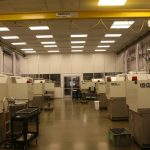 Lean is one of the most popular principles applied in the manufacturing industry today. Developed within the Toyota Production System, these concepts are now widespread throughout all manufacturing sectors. The basic concept is to eliminate anything that does not add value, or that which is waste. Waste comes by way of materials, efforts, and time. A lean operation is streamlined and flexible, and can absolutely be applied to the cleanroom.
Lean is one of the most popular principles applied in the manufacturing industry today. Developed within the Toyota Production System, these concepts are now widespread throughout all manufacturing sectors. The basic concept is to eliminate anything that does not add value, or that which is waste. Waste comes by way of materials, efforts, and time. A lean operation is streamlined and flexible, and can absolutely be applied to the cleanroom.
Lean principles can be applied to both future and existing cleanrooms. Here are some guidelines:
- Strategic location (new cleanroom): consider everything that goes into the entire process of making and delivering your product. What kind of supplies do you need? What kind of storage? Who are your customers? How will your product be transported? What future needs will you have? Selecting a location that is close to suppliers, warehouses, major transportation and the like can significantly cut time and cost from your future operation.
- Building and cell layout (new cleanroom): while these are two separate plans, each can be constructed according to lean guidelines. For the building, Look at all the factors that you can’t change, like zoning and operability (e.g. drainage, power) requirements. For anything in the building these predetermined constraints effect, plan your layout around them.
- For the cell layout, consider how you can optimize the time it takes to complete each task involved in each step of the process. Can you create a work cell around a piece/pieces of necessary equipment so that workers don’t have to move from room to room?
- Workstations (new and existing cleanrooms): consider how to make each workstation mistake-proof, organized, and, when possible, intuitive. Additionally, evaluate all ways that contamination can be prevented or removed. Eliminating excess cleaning saves a lot of wasted time. Similarly, carefully select cleaning products and train employees on how to use them. Over cleaning can compromise the surface structure, creating more problems.
- Communicate effectively with suppliers and customers (new and existing cleanrooms): know exactly what your customers need, and communicate that to your suppliers. Create standardized, transparent processes that are in agreement with your clients’ needs and suppliers’ capabilities. Make sure everyone is on the same page.
For each individual manufacturer, evaluate what activities waste the most time, whether they’re related to accidents, space restrictions, miscommunication, or whatever else does not add value to your process. Once these activities are identified, you can plan a strategy to eliminate them.
Gerbig Engineering Company experts can help you construct a cleanroom that meets your lean needs. Planning ahead is part of the lean process, too.